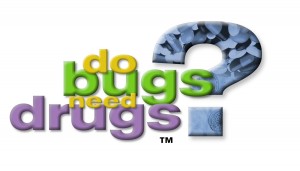Guest post by Stuart Shepherd and Dr. David Patrick
Until the discovery of antibiotics in the mid-20th century, bacterial diseases played a gruesome role in the human canon. Plagues swept through the population with harrowing frequency; minor infections spread and disfigured; and 30% of all deaths occurred in children under 5 years old. Life was relatively short, and accompanied by immeasurable suffering.
Antibiotics opened a window of opportunity for the human species: we were able to fight back against chronic illness, improving our quality of life and extending the human lifespan. Antibiotics allowed the advance of health research, and we quickly developed procedures that were once impossible due to the high risk of infection: organ transplants, kidney dialysis, tissue grafting, and chemotherapy.
Antibiotics are some of most powerful tools available to combat diseases and improve human welfare, and we are losing them.
“Every antibiotic prescription represents a balance of benefits and risks, both to the individual and the population.”
– Dr. David Patrick, Antibiotic use and population ecology: How you can reduce your resistance footprint, Canadian Medical Association Journal 180(4), 416-421, Feb 17, 2009
Just as our medical system flourished and evolved, the bacteria we combat are evolving past current antimicrobial drugs. Despite employing some of the brightest minds in the world – plus decades of research and tens of billions of dollars – to discover new drug therapies, we are now faced with bacteria that are able to side step entire families of drugs.
Once deemed magic bullets against bacterial infections, antibiotics are en route to becoming partially – or even wholly – obsolete. Despite growing awareness, improper antibiotic use persists, contributing to increasing resistance rates. In the US alone, antibiotic resistant bacteria are directly responsible for over 23,000 deaths per year, and 2 million related illnesses.
“This is not a regional phenomenon. This is not a phenomenon occurring in just poor countries… this is something occurring in all countries of the world.”
– Dr. Keiji Fukuda, WHO Assistant Director-General for Health Security, Apr 30, 2014
A growing number of political initiatives worldwide are underway to halt the rise in antibiotic resistance. In 1997, the Canadian Committee on Antibiotic Resistance issued a mandate to decrease the use of antibiotics for respiratory tract infections by 25%. Alberta responded in 1998 by establishing the Do Bugs Need Drugs? program, a community program for the proper use of antibiotics.
Do Bugs Need Drugs? aimed to reduce prescription rates for respiratory illnesses by educating both the public and health-care professionals. The program has since been adapted in British Columbia (BC) under the BC Centre for Disease Control, and has three tenets:
- handwashing is the best way to stop the spread of infections
- not all bugs are created equal
- use antibiotics wisely to stop bacteria from becoming resistant to antibiotics
To increase public awareness, the Do Bugs Need Drugs? program has developed school curriculum content, workplace health and safety materials, and a comprehensive website. The program is presented in classrooms, at seminars and at fairs, and print materials are available online and by mail. Health sciences students from campuses across the province contribute to the program’s delivery. Accompanied by the less-than-charming ‘Bugsy’ mascot, the program reaches the farthest corners of BC and Alberta, educating and increasing awareness about antibiotic resistance.
Do Bugs Need Drugs? focuses not only on education, but also on analyzing province-wide epidemiological trends. The program utilizes data from the Centre for Disease Control to monitor resistance rates and track local antibiotic resistance. These data are used by provincial and federal governments in health legislation, both domestically and globally.
Resistance trends are also used to inform those on the other side of the prescription pad. By keeping doctors up to date with the latest information, the program aims to alter and improve prescription patterns in the medical community, a key part of proper antibiotic stewardship. Do Bugs Need Drugs? even offers an accredited continuing education program to physicians, and produces a comprehensive guide on antibiotic prescribing (also available as an app, for tech-savvy docs).
The program has had a marked impact. Since 2006, overall rates of antibiotic use in BC have stabilized, with declining prescription rates for some families of resistance-prone antibiotics. Over 51,000 children and adults have received program materials, with many more heading online to DoBugsNeedDrugs.org for illness information, public service announcements and hand washing tips.
It is estimated that in just a matter of decades, resistance to antibiotics could render our drugs useless. Infection incidence from regular hospital procedures could skyrocket, and minor illnesses could be incurable. Diversion from this course requires an educated public and health-care system, and Do Bugs Need Drugs? is a component in the achievement of that goal.
Follow @DoBugsNeedDrugs for program activities and the latest news about antibiotic resistance.
Additional resources:
http://www.bccdc.ca/prevention/AntibioticResistance/DBND/default.htm
http://www.whitehouse.gov/sites/default/files/docs/carb_national_strategy.pdf






